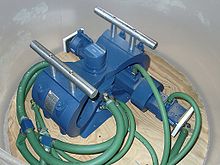Amplitron
The Amplitron is a high-performance tube in the microwave range and belongs to the group of time-of-flight tubes in which the flow of electrons interacts with an electromagnetic wave traveling along a delay line. Its structure is very similar to the magnetron .

The following terms are used for the Amplitron in the literature, which sometimes also mark different purposes:
Crossed-field amplifier (engl. Crossed field amplifier , short CFA ) is the function designating preamble of reinforcing runtime tubes transverse to the electron current magnetic field.
Platinotron (from the Greek platino - plateau) is the original generic term for CFA.
Amplitron CFA as a switchable power amplifier. The Amplitron designation is a trademark of Raytheon Manufacturing Company.
Stabilotron : Special form of the amplitron with feedback and resonance circuit as a stable HF generator.
The term magnetron amplifier is a trivial name.
Layout and function

The main difference between the magnetron and the Amplitron is that the Amplitron has an odd number of resonators at the anode and does not have a closed delay system with only one output, but has both an input and an output.
The space between the cathode and anode is called the running space. A strong magnetic field from a permanent magnet is parallel to the cathode. In the running space, the electrostatic field of the anode voltage and the magnetic field of the permanent magnet act on the electrons. Since its magnetic lines of force point perpendicular to the electrostatic lines of force between anode and cathode, i.e. they cross, this tube is also called a cross-field amplifier .
Due to the deflection by the magnetic field, the electrons do not move on the shortest path to the anode, but on more circular paths roughly parallel to the delay line. The high frequency to be amplified is now so high that the electrons are too slow, despite their acceleration by the electrostatic field, to reach the anode within one period of oscillation.
The high frequency applied to the input is superimposed with its voltage on the high voltage. The electrons are now, depending on the current amplitude of the high frequency, sometimes decelerated (negative half-wave of the oscillation), sometimes additionally accelerated (positive half-wave). Therefore electrons now exist in the moving space with different speeds. The slower electrons are caught up by the faster electrons and so strong electron bunches are formed, which can now deliver energy to the delay line in time with the high frequency. The amplified high-frequency signal can now be tapped at the output.
Cold platinum electrodes are also used as cathodes; they work on the basis of secondary electron emission and have the advantage over hot cathodes of a significantly longer service life (lower evaporation rate) and insensitivity to bombardment with residual gas ions. Lifetimes of up to around 20,000 hours are achieved.
If the anode voltage (high voltage up to approx. 60 kV) of the amplitron is switched off, the input signal is passed to the output without amplification and slightly attenuated. The power of the amplifier can thus be modulated by switching or varying the high voltage. The switching of the high voltage can be done with thyratrons or switching triodes .
Amplitrons have a similarly high degree of efficiency as magnetrons (22 to over 70%) and, as an HF generator (combination oscillator - amplifier or fed back via a resonance circuit), have a lower phase or frequency jitter compared to them .
Amplitrons can work on poorly matched loads (see standing wave ratio ): while with other microwave generators, waves reflected by the load lead to increased power loss or phase errors, they pass the Amplitron backwards and leave it via its input. Before this, they can be decoupled and attenuated with a directional coupler / circulator .
use
Pulsed amplitrons are used as high-frequency amplifiers (around 100 MHz to over 10 GHz) in radar devices and particle accelerators . They can generate pulse powers of several megawatts and continuous powers of several 100 kW and, compared to klystron amplifiers, have the advantage of lower frequency and phase deviations when the anode voltage changes, which makes them easier to modulate.
Modulated amplitrons (CFA) are used for data communication in space travel.
They are also used in continuous operation for industrial purposes (heating purposes, plasma excitation).
Web links
- Manufacturer L-3 - data from CFA with comparison table to Raytheon types
Individual evidence
- ↑ http://epaper.kek.jp/p65/PDF/PAC1965_0169.PDF Pulse amplitrons for particle accelerators
- ↑ http://www.ostron.de/seiten/roehren_angebots_liste/magnetron/umi_201/umi_201.htm type UMI201 from Ostron
- ↑ http://epaper.kek.jp/p65/PDF/PAC1965_0169.PDF and others on the phase error of amplitrons for particle accelerators
- ↑ Archived copy ( Memento of the original from July 8, 2008 in the Internet Archive ) Info: The archive link was inserted automatically and not yet checked. Please check the original and archive link according to the instructions and then remove this notice.